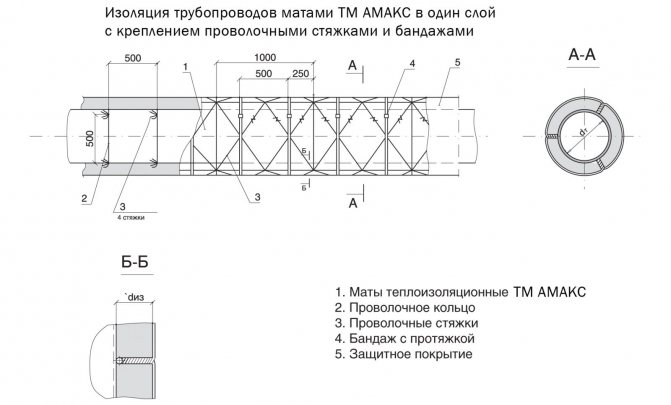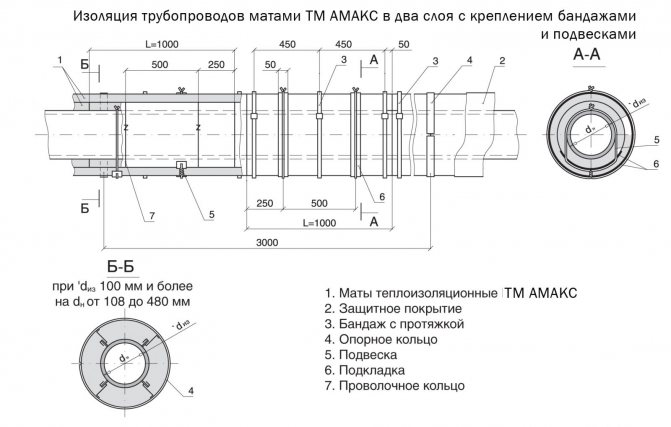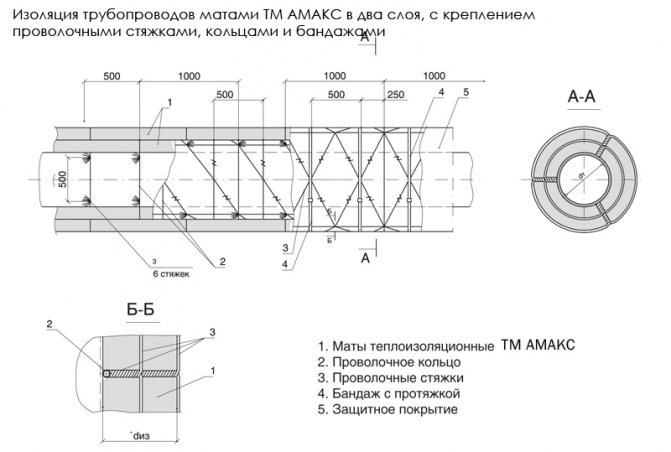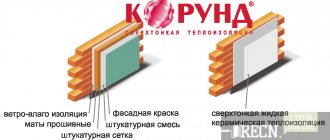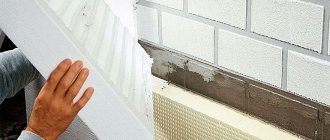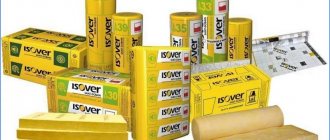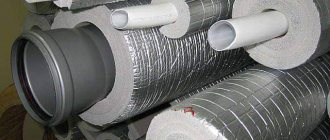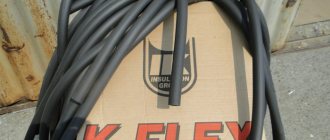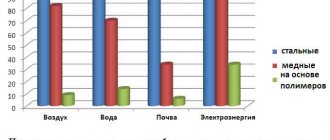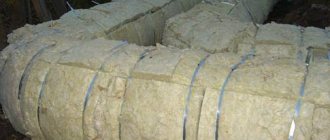Pipeline insulation design
Insulation design for pipelines with an outer diameter of 15 to 159 mm, for a heat-insulating layer made of stitched glass staple fiber mats on a synthetic binder, stitched mats made of mineral and basalt wool, mats made of basalt or glass super-thin fiber, the following fastening is used:
- for pipelines with an outer diameter of the heat-insulating layer not exceeding 200 mm - fastening with a wire with a diameter of 1.2-2 mm in a spiral around the heat-insulating layer, while the spiral is fixed on wire rings along the edges of the mats. If mats are used in the plates, then the edges of the plates are stitched with glass thread, silica thread, roving or wire 0.8 mm in diameter;
Thermal insulation construction made of fibrous materials for pipes with a diameter of not more than 200 mm.
1. Mats or canvases made of fiberglass or mineral wool; 2. Spiral fastening from a wire with a diameter of 1.2 - 2.0 mm, 3. A ring from a wire with a diameter of 1.2 - 2.0 mm, 4. Covering layer.
- for pipelines with an outer diameter of 57-159 mm:
- when laying mats in one layer - with bandages made of tape 0.7 × 20 mm. The step of installing the bands depends on the size of the products used, but not more than 500 mm. When laying mats with a width of 1000 mm, the bandages are recommended to be installed with a pitch of 450 mm with an offset of 50 mm from the edge of the product. On a product with a width of 500 mm, 2 bands should be installed;
Insulation of pipelines with an outer diameter of 57 to 219 mm.
but. Insulation in one layer; b. Insulation in two layers.
1. heat-insulating layer made of fibrous materials, 2. ring made of wire with a diameter of 1.2 - 2.0 mm, 3. bandage with buckle, 4. cover layer.
- when laying mats in two layers - with rings made of wire with a diameter of 2 mm for the inner layer of two-layer structures, with bandages - for the outer layer of two-layer heat-insulating structures. Bandages made of tape 0.7 × 20 mm are installed on the outer layer in the same way as in a single-layer construction.
Black steel bandages should be painted to prevent corrosion. The edges of the covers are sewn together as described above. With two-layer insulation, the edges of the inner layer plates are not stitched together. When molded products, cylinders or segments are used for thermal insulation of pipelines, their fastening is carried out with bandages. Two bands are installed when insulated with cylinders. When insulating with segments, it is recommended to install bands with a pitch of 250 mm with a product length of 1000 mm.
The structure of the insulation of pipelines with an outer diameter of 219 mm and more for the heat-insulating layer of mats, the following fastening is used:
- when laying products in one layer - bandages made of tape 0.7 × 20 mm and hangers made of wire with a diameter of 1.2 mm. The hangers are evenly spaced between the bands and are attached to the pipeline. Under the pendants, fiberglass pads are installed when using uncoated mats (Fig. 2.160). When using mats in the covers, the pads are not installed. Fiberglass covers are stitched;
- when laying products in two layers with rings made of wire with a diameter of 2 mm and hangers made of wire with a diameter of 1.2 mm for the inner layer of two-layer structures. The second layer pendants are attached to the first layer pendant from below. Bandages made of tape 0.7 × 20 mm are installed on the outer layer in the same way as in a single-layer construction.
Insulation of pipelines with an outer diameter of 219 mm and more with heat-insulating materials made of fibrous materials in one layer.
1 - suspension, 2 - heat-insulating layer, 3 - support bracket (support ring), 4 - bandage with buckle. 5 - lining, 6 - cover layer.
The thermal insulation layer is laid with a thick seal. In two-layer constructions, the mats of the second layer should overlap the seams of the inner layer. For pipelines with an outer diameter of 273 mm and more, in addition to mats, mineral wool slabs with a density of 35-50 kg / m3 can be used, although the optimal field of application is for pipelines with an outer diameter of 530 mm and more. When insulating with slabs, the heat-insulating layer can be fastened with bandages and suspensions. The arrangement of fasteners - bands, hangers and rings (with two-layer insulation) is selected taking into account the length of the plates used. Under the pendants, lining made of rolled fiberglass or roofing material is installed. When using slabs cached with fiberglass, glass mat, fiberglass, backings are not installed. The slabs are laid with the long side along the pipeline.
Insulation of a pipeline with an outer diameter of 219 mm and more with heat-insulating materials made of fibrous materials in two layers:
1 - heat-insulating layer, 2 - bandage with a buckle, 3 - support ring, 4 - cover layer, 5 - stitching (for products in plates), 6 - pendant, 7 - lining, 8 - wire ring.
In heat-insulating structures with a thickness of less than 100 mm, when using a metal protective coating, support brackets should be installed on horizontal pipelines. The clamps are installed on horizontal pipelines with a diameter of 108 mm and above with a step of 500 mm along the length of the pipeline. On pipelines with an outer diameter of 530 mm and more, three brackets are installed in diameter at the top of the structure and one at the bottom. Support brackets are made of aluminum or galvanized steel (depending on the material of the protective coating) with a height corresponding to the thickness of the insulation.
In horizontal heat-insulating structures of pipelines with a diameter of 219 mm and more with positive temperatures and an insulation thickness of 100 mm or more, support rings are installed. For pipelines with negative temperatures in the supporting structures there should be gaskets made of fiberglass, wood or other low-thermal conductivity materials to eliminate "cold bridges".
When insulating with shape-stable thermal insulation materials such as cylinders, mineral wool or fiberglass segments, as well as KVM-50 mats with vertical fiber orientation (manufactured by Isover) or Lamella Mat, support structures for horizontal sections are not required.
Insulation design for vertical pipelines with an outer diameter of up to 476 mm. The heat-insulating layer is fastened with bandages and wire rings. To prevent slipping of rings and bandages, wire strings with a diameter of 1.2 or 2 mm should be installed.
On vertical pipelines with an outer diameter of 530 mm or more, the heat-insulating layer is fastened on a wire frame with the installation of wire strings that prevent the fastening elements (rings, bands) from sliding off. Rings made of wire with a diameter of 2-3 mm are installed along the length of the pipeline on its surface with a pitch of 500 mm for slabs 1000 mm long and 500 mm wide and mats 500 and 1000 mm wide. Bundles of wire ties with a diameter of 1.2 mm are attached to the rings with a step along the arc of the ring of 500 mm.
There are four screeds in a bundle when insulating in one layer and six - when insulating in two layers. When using mats with a width of 1000 mm, the screeds pierce the thermal insulation layers and fasten them crosswise. When using mats with a width of 500 mm and slabs with a width of 500 mm, the screeds pass at the joints of the products.
Bandages made of tape 0.7 × 20 mm with buckles are installed with a step depending on the width of the product, 2-З pcs. per product (plate or mat 1000-1250 mm wide) with single-layer insulation and along the outer layer with two-layer insulation. Instead of bandages, rings made of wire with a diameter of 2 mm can be installed along the inner layer of two-layer insulation.
When using mats with a width of 500 mm, two bands (or rings) should be installed on the product. The edges of the mats in the covers are sewn with 0.8 mm wire or glass wool, depending on the type of cover. The strings can be attached to unloading devices, which are installed with a pitch of 3-4 m in height, or rings made of wire with a diameter of 5 mm, welded to the surface of the pipeline or its other elements.
Insulation design for vertical pipelines, unloading devices are installed with a step of 3-4 m in height.
When insulating cold water pipelines, pipelines transporting substances with negative temperatures, as well as pipelines of heating networks of underground laying, galvanized wire, galvanized steel or painted steel bands should be used for fastening structural elements.
> Technologies for installation of thermal insulation of pipelines
Mats XOTPIPE VLM
Rolls XOTPIPE VLM - mineral wool mats lined with aluminum foil.
Rolls XOTPIPE VLM are vertically layered mats, they are also called lamellar mats, which are made from mineral wool based on basalt rocks with a synthetic binder. Themselves mats XOTPIPE VLM are made of special lamellas, vertical strips of mineral wool, glued on a backing of aluminum (ALU) foil, reinforced with glass mesh. There is another type of XOTPIPE VLM mineral wool mats, these are HOTPIPE VLM mats with OUTSIDE coating. These mats are made in the same way as simple HOTPIPE VLM mats, but they have a different backing. Instead of aluminum foil reinforced with a glass mesh, they have a substrate of glass cloth with a density of 150 g / m2, covered with aluminum foil, with a foil thickness (ALU) of 50 microns.
Thermal insulation mats XOTPIPE VLM (rolls) are produced with a density of 35-50 and 75 kg / m³ (mats with a density of 35 kg / m³ are considered standard), with a thickness of 20 to 150 mm, a length of 2500 to 15000 mm, and a standard width of 100 m. XOTPIPE mineral wool mats are available in rolls with a roll height of 1050 mm, an average roll diameter of 750 mm, and are supplied in plastic bags. XOTPIPE VLM mineral wool mats are manufactured in accordance with TU 5769-001-62815391-2009 and have all the necessary documents and certificates.
Advantages of XOTPIPE VLM lamellar mats
- the dimensions of pipes and equipment for insulation are practically unlimited
- have great strength and elasticity
- retain their original shape under loads
- can be used with all types of thermal insulation materials
Application of XOTPIPE VLM lamellar mats
Mineral wool mats HOTPIPE VLM are used for thermal insulation and sound insulation of various equipment and pipelines of round and rectangular shape, including for insulation of pipelines with large diameters over 100 mm. They are also widely used for thermal insulation of ventilation ducts and tanks. Simple mats HOTPIPE VLM are usually used as one of the bases in various thermal insulation structures, and XOTPIPE VLM mats with OUTSIDE coating can be used as an independent thermal insulation that does not need additional vapor barrier and protection from mechanical damage.
Technical characteristics of XOTPIPE VLM lamella mats
| Name | Value | |
| Length | 2500 -15000 mm | |
| Thickness | 20-150 mm | |
| Width: (standard) | 1000 mm | |
| Working temperature* | –180 ° С to + 350 ° С | |
| Density | 35 (standard) -50-75 kg / m³ | |
| Compressive strength (at 10% deformation) | from 5 to 10 kN / m² | |
| Dry heat conductivity, λ W / (m * K), no more: (for a density of 35 kg / m³): | λ10 = 0.036 | |
| λ25 = 0.038 | ||
| λ100 = 0.050 | ||
| λ200 = 0.075 | ||
| Fire classification | group G1 (slightly flammable) according to GOST 30244 | NG |
| group B1 (hardly flammable) according to GOST 30402-96 | NG | |
| group D1 (with low smoke-generating capacity) according to GOST 12.1.044-89 | NG | |
| Water absorption at full immersion,% by volume | no more than 1.5%. | |
| Linear expansion coefficient | = 0 | |
* The temperature on the surface of the coating (ALU foil) should not exceed + 80 ° C (temperature limits depend on the heat resistance of the coating adhesive).
Price list, prices for XOTPIPE VLM lamellar mats
Insulation of pipelines with stitched mineral wool mats
Insulation of pipelines with stitched mineral wool mats
For this type of work, mats are used either without cover, or in covers made of metal mesh (up to a temperature of 700 ° C), of glass fabric (up to a temperature of 450 ° C) and cardboard (up to a temperature of 150 ° C). Uncoated mats can also be used for low-temperature insulation (down to -180 ° C). Scope of work 1. Cutting products to a given size. 2. Stacking of products with fit in place. 3. Fastening products with wire rings. 4. Sealing with waste products. 5. Sewing joints (mats in covers). 6. Additional fastening of products with wire rings or bandages (along the top layer). Non-lined mats are used to insulate pipelines with a diameter of 57-426 mm, and mats with lining are used on pipelines with a diameter of 273 mm and more. Products are laid on the surface of pipelines in one or two layers with overlapping seams and secured with banding rings made of packing tape with a section of 0.7 × 20 mm or steel wire with a diameter of 1.2-2.0 mm, installed every 500 mm. The heat-insulating layer on pipelines with a diameter of 273 mm and more must have additional fastening in the form of wire hangers (Fig. 1).
Fig. 1. Insulation with mineral wool wired mats: a - pipelines: 1 - wire suspension with a diameter of 2 mm (used for pipelines with a diameter of 273 mm and more); b - gas ducts: 1 - fixing pins with a diameter of 5 mm; 2 - heat-insulating product; 3 - stitching with a wire with a diameter of 0.8 mm; 4 - wire with a diameter of 2 mm (fastening the lower layer); c - flat surfaces: 1 - mineral wool mats; 2- pins before laying the insulating layer; 3 - pins after laying the insulating layer; 4 - stitching with a wire with a diameter of 0.8 mm; d - spheres: 1 - stitching with a wire with a diameter of 0.8 mm; 2 - wire ring; 3 - wire bandages; 4 - mineral wool products; 5 - fixing pins
When insulating pipelines with products in metal mesh covers, the longitudinal seams must be stitched with a wire with a diameter of 0.8 mm. For pipes with a diameter of more than 600 mm, transverse seams are also sewn. Mineral wool wired mats are compacted during installation and reach the following density (according to GOST in the design), kg / m; mats brand 100-100 / 132; brands 125-125 / 162.
Network Layout Characteristics and Regulatory Computing
Performing calculations to determine the thickness of the heat-insulating layer of cylindrical surfaces is a rather laborious and complex process. If you are not ready to entrust it to specialists, you should stock up on attention and patience to get the right result. The most common way to calculate pipe insulation is to calculate it using standardized heat loss indicators. The fact is that SNiPom established the values of heat loss by pipelines of different diameters and with different methods of their laying:
Pipe insulation scheme.
- in an open way on the street;
- open in a room or tunnel;
- channelless method;
- in impassable channels.
The essence of the calculation is in the selection of heat-insulating material and its thickness in such a way that the value of heat losses does not exceed the values prescribed in SNiP. The calculation technique is also regulated by regulatory documents, namely, by the relevant Code of Rules. The latter offers a slightly more simplified methodology than most of the existing technical reference books. Simplifications are contained in the following points:
- Heat losses during heating of the pipe walls by the medium transported in it are negligible compared to the losses that are lost in the outer insulation layer. For this reason, they are allowed to be ignored.
- The vast majority of all process and network piping is made of steel, its resistance to heat transfer is extremely low. Especially when compared with the same indicator of insulation.Therefore, it is recommended not to take into account the resistance to heat transfer of the metal pipe wall.
Description and standard sizes of stitched mats:
Basalt wired mats MP 100 have a density of 100 kg / cubic meter, are produced in a standard width of 1000 mm and have a length of 6000 mm to 2500 mm, depending on the thickness of the mat. The MP mat can have a thickness of 40 to 120 mm, depending on the application. An important feature of wired mats is their increased resistance to high temperatures. For a long time, they protect building structures from damage, and also prevent the spread of fire. The maximum possible heating temperature can reach + 750 ° C. Basalt insulation is able to best protect equipment not only from heat loss, but also from fire.
Mineral wool stitched mats have good elasticity, resistance to compression and stretching. As a result, heat-insulating wired mats have a wider range of applications and are more durable than conventional technical mats.
The method of calculating a single-layer thermal insulation structure
The basic formula for calculating the thermal insulation of pipelines shows the relationship between the magnitude of the heat flux from the operating pipe, covered with a layer of insulation, and its thickness. The formula is applied if the pipe diameter is less than 2 m:
The formula for calculating the thermal insulation of pipes.
ln B = 2πλ
In this formula:
- λ is the thermal conductivity coefficient of the insulation, W / (m ⁰C);
- K - dimensionless coefficient of additional heat losses through fasteners or supports, some K values can be taken from Table 1;
- tт - temperature in degrees of the transported medium or heat carrier;
- tо - outdoor air temperature, ⁰C;
- qL is the heat flux, W / m2;
- Rн - resistance to heat transfer on the outer surface of the insulation, (m2 ⁰C) / W.
Table 1
| Pipe laying conditions | The value of the coefficient K |
| Steel pipelines are open along the street, along canals, tunnels, open indoors on sliding supports with a nominal diameter of up to 150 mm. | 1.2 |
| Steel pipelines are open along the street, through canals, tunnels, open indoors on sliding supports with a nominal diameter of 150 mm and more. | 1.15 |
| Steel pipelines are open along the street, along canals, tunnels, open indoors on suspended supports. | 1.05 |
| Non-metallic piping laid on overhead or sliding supports. | 1.7 |
| Channelless way of laying. | 1.15 |
The value of the thermal conductivity λ of the insulation is a reference, depending on the selected thermal insulation material. It is recommended to take the temperature of the transported medium tt as the average temperature throughout the year, and of the outside air tо as the average annual temperature. If the insulated pipeline passes through the room, then the ambient temperature is set by the technical design assignment, and in its absence it is assumed to be + 20 ° C. The indicator of resistance to heat transfer on the surface of a heat-insulating structure Rн for outdoor installation conditions can be taken from Table 2.
table 2
Note: the value of Rn at intermediate values of the coolant temperature is calculated by interpolation. If the temperature indicator is below 100 ⁰C, the Rn value is taken as for 100 ⁰C.
Indicator B should be calculated separately:
Heat loss table for different pipe thicknesses and thermal insulation.
B = (dfrom + 2δ) / dtr, here:
- diz - outer diameter of the heat-insulating structure, m;
- dtr - outer diameter of the protected pipe, m;
- δ is the thickness of the heat-insulating structure, m.
The calculation of the insulation thickness of pipelines begins with determining the indicator ln B, substituting the values of the outer diameters of the pipe and the thermal insulation structure, as well as the layer thickness, into the formula, after which the parameter ln B is found from the table of natural logarithms. It is substituted into the basic formula together with the indicator of the normalized heat flux qL and calculate.That is, the thickness of the pipeline insulation must be such that the right and left sides of the equation become identical. This thickness value should be taken for further development.
The considered calculation method applied to pipelines with a diameter of less than 2 m.For pipes with a larger diameter, the calculation of insulation is somewhat simpler and is performed both for a flat surface and according to a different formula:
δ =
In this formula:
- δ is the thickness of the heat-insulating structure, m;
- qF is the value of the normalized heat flux, W / m2;
- other parameters - as in the calculation formula for a cylindrical surface.
Linear dimensions
Mineral mats from different manufacturers have different sizes and the same rectangular shape. Due to the similarity of the main operational parameters, it is not necessary to be tied to any one manufacturer. It is necessary to choose those materials that are optimal for the insulated equipment, installation, pipeline.
The length varies from 2.4 to 12 meters depending on the thickness. This leads to the convenience of storage and transportation to the work site.
Wired mats have a width of 1 or 1.2 m. This value allows one person to carry out insulation work while observing safety requirements.
The thickness ranges from 20 to 100 mm, ensuring the selection of such a layer thickness that will allow the insulation to be carried out according to the calculated values with saving money for the purchase.
The method of calculating a multilayer thermal insulation structure
Insulation table for copper and steel pipes.
Some transported media have a sufficiently high temperature, which is transferred to the outer surface of the metal pipe practically unchanged. When choosing a material for thermal insulation of such an object, they face such a problem: not every material is able to withstand high temperatures, for example, 500-600-6C. Products capable of contacting such a hot surface, in turn, do not have sufficiently high thermal insulation properties, and the thickness of the structure will turn out to be unacceptably large. The solution is to use two layers of different materials, each of which performs its own function: the first layer protects the hot surface from the second, and the latter protects the pipeline from the effects of low outside temperature. The main condition for such thermal protection is that the temperature at the boundary of the layers t1,2 is acceptable for the material of the outer insulating coating.
To calculate the insulation thickness of the first layer, the formula already given above is used:
δ =
The second layer is calculated using the same formula, substituting the temperature at the boundary of two heat-insulating layers t1,2 instead of the value of the pipeline surface temperature tt. To calculate the thickness of the first layer of insulation on cylindrical surfaces of pipes with a diameter of less than 2 m, a formula of the same type is used as for a single-layer structure:
ln B1 = 2πλ
Substituting instead of the ambient temperature the heating value of the boundary of the two layers t1,2 and the normalized value of the heat flux density qL, the value ln B1 is found. After determining the numerical value of the parameter B1 through the table of natural logarithms, the thickness of the insulation of the first layer is calculated using the formula:
Data for calculating thermal insulation.
δ1 = dfrom1 (B1 - 1) / 2
The calculation of the thickness of the second layer is performed using the same equation, only now the temperature of the boundary of the two layers t1,2 acts instead of the temperature of the coolant tt:
ln B2 = 2πλ
Calculations are done in a similar way, and the thickness of the second thermal insulation layer is calculated using the same formula:
δ2 = dfrom2 (B2 - 1) / 2
It is very difficult to carry out such complex calculations manually, and a lot of time is wasted, because throughout the entire route of the pipeline, its diameters can change several times.Therefore, in order to save labor costs and time for calculating the insulation thickness of technological and network pipelines, it is recommended to use a personal computer and specialized software. If there is none, the calculation algorithm can be entered into the Microsoft Excel program, while getting the results quickly and successfully.
Method for determination by a given value of the decrease in the temperature of the coolant
Materials for thermal insulation of pipes according to SNiP.
A task of this kind is often posed in the event that the transported medium must reach the final destination through pipelines at a certain temperature. Therefore, the determination of the thickness of the insulation is required to be done for a given value of temperature reduction. For example, from point A the coolant leaves through a pipe with a temperature of 150⁰C, and to point B it must be delivered with a temperature of at least 100⁰C, the difference should not exceed 50⁰C. For such a calculation, the length l of the pipeline in meters is entered into the formulas.
First, you should find the total resistance to heat transfer Rp of the entire thermal insulation of the object. The parameter is calculated in two different ways, depending on the observance of the following condition:
If the value (tt.init - to) / (tt.con - to) is greater than or equal to the number 2, then the value of Rp is calculated by the formula:
Rп = 3.6Kl / GC ln
In the above formulas:
- K - dimensionless coefficient of additional heat losses through fasteners or supports (Table 1);
- tt.init - the initial temperature in degrees of the transported medium or heat carrier;
- tо - ambient temperature, ⁰C;
- tt.con - the final temperature in degrees of the transported medium;
- Rп - total thermal resistance of insulation, (m2 ⁰C) / W
- l is the length of the pipeline route, m;
- G — consumption of the transported medium, kg / h;
- C is the specific heat capacity of this medium, kJ / (kg ⁰C).
Thermal insulation of basalt fiber steel pipe.
Otherwise, the expression (tt.init - to) / (tt.fin - to) is less than 2, the value of Rp is calculated as follows:
Rп = 3.6Kl: GC (tt.start - tt.end)
The parameter designations are the same as in the previous formula. The found value of the thermal resistance Rp is substituted into the equation:
ln B = 2πλ (Rп - Rн), where:
- λ is the thermal conductivity coefficient of the insulation, W / (m ⁰C);
- Rн - resistance to heat transfer on the outer surface of the insulation, (m2 ⁰C) / W.
Then they find the numerical value of B and calculate the insulation according to the familiar formula:
δ = dfrom (B - 1) / 2
In this method of calculating the insulation of pipelines, the ambient temperature tо should be taken according to the average temperature of the coldest five days. Parameters К and Rн - according to the above tables 1,2. More detailed tables for these values are available in the regulatory documentation (SNiP 41-03-2003, Code of Practice 41-103-2000).
Technical characteristics of mineral wool mats
| Fire classification | NG for TR and TR-Combi in the following versions: plain, WR, ME, WM, without coating or with sewn-on coatings ALU1, ST, MG. G1, B1, D1, T1 for TR and TR-Combi in versions: simple, WR, ME, WM, with ALU, OUTSIDE, PA, CB covers / coatings, |
| Range of working temperatures | from -200 to +700 ° С For TR from -200 to +950 ° С For TR-Combi |
| Standard sizes | -thickness from 50 to 250 mm (step 10 mm) |
| Density, kg / m³ | from 25 to 100 for simple mats from 50 to 150 for stitched mats |
| Dry heat conductivity W / (m * K) | from 0.036 to 0.04 (at 25 ° С depending on density) |
| Certificates | certificate of conformity, fire safety, sanitary and epidemiological conclusion |
| Application area | thermal insulation of equipment, pipelines (air ducts, gas ducts) in engineering systems for heating, ventilation, air conditioning of buildings, industrial enterprises, highways, external heating mains, etc. |
Method for determination by a given temperature of the surface of an insulating layer
This requirement is relevant in industrial enterprises where various pipelines pass inside premises and workshops in which people work.In this case, the temperature of any heated surface is normalized in accordance with the rules of labor protection in order to avoid burns. The calculation of the thickness of the insulating structure for pipes with a diameter of over 2 m is carried out in accordance with the formula:
Formula for determining the thickness of thermal insulation.
δ = λ (tt - tp) / ɑ (tp - t0), here:
- ɑ - heat transfer coefficient, taken according to reference tables, W / (m2 ⁰C);
- tp - normalized temperature of the surface of the heat-insulating layer, ⁰C;
- other parameters are the same as in the previous formulas.
The calculation of the thickness of the insulation of a cylindrical surface is carried out using the equation:
ln B = (dfrom + 2δ) / dtr = 2πλ Rn (tt - tp) / (tp - t0)
The designations of all parameters are the same as in the previous formulas. According to the algorithm, this miscalculation is similar to calculating the thickness of the insulation for a given heat flow. Therefore, further it is performed in the same way, the final value of the thickness of the heat-insulating layer δ is found as follows:
δ = dfrom (B - 1) / 2
The proposed method has some error, although it is quite acceptable for preliminary determination of the parameters of the insulation layer. A more accurate calculation is performed by the method of successive approximations using a personal computer and specialized software.

